Lynn University ESE 515: Critical Assignment on Evidence-Based
VerifiedAdded on 2023/04/23
|22
|4796
|353
Report
AI Summary
This report provides a comprehensive overview of evidence-based practices (EBP) for various disabilities, including Emotional Behavior Disorder (EBD), Autism Spectrum Disorder (ASD), Specific Learning Disability (SLD), and Speech Impairment (SI). It details strategies such as Possible Selves, Social Stories, Mind Reading, Sentence Writing Strategy, and Picture Exchange Communication System (PECS). The report also covers interventions for processing deficits, like Hop, Skip, & Jump, Fast ForWord, Brain Gym, Lexia Cross-Trainer, and Cloze Notes. Furthermore, it explores EBP in content areas by school level, including Literacy Express for Pre-K reading, Instructional Conversation and Literature Logs for elementary writing, and Odyssey for middle school math. The report emphasizes accommodations for ELL students within each strategy and highlights the importance of tailoring interventions to meet individual student needs. This assignment showcases a detailed understanding of applying research-backed methods to enhance educational outcomes for diverse learners.
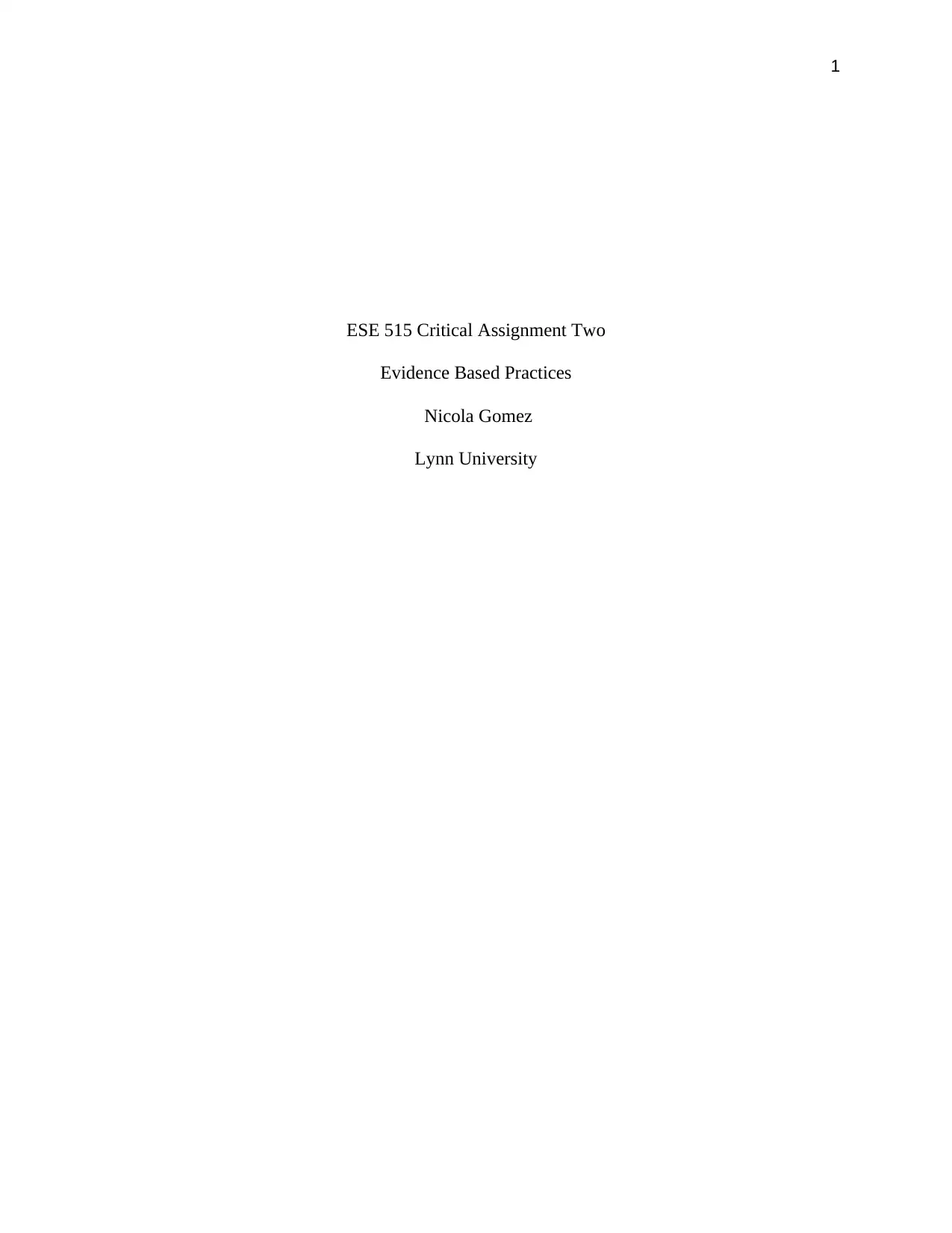
1
ESE 515 Critical Assignment Two
Evidence Based Practices
Nicola Gomez
Lynn University
ESE 515 Critical Assignment Two
Evidence Based Practices
Nicola Gomez
Lynn University
Paraphrase This Document
Need a fresh take? Get an instant paraphrase of this document with our AI Paraphraser
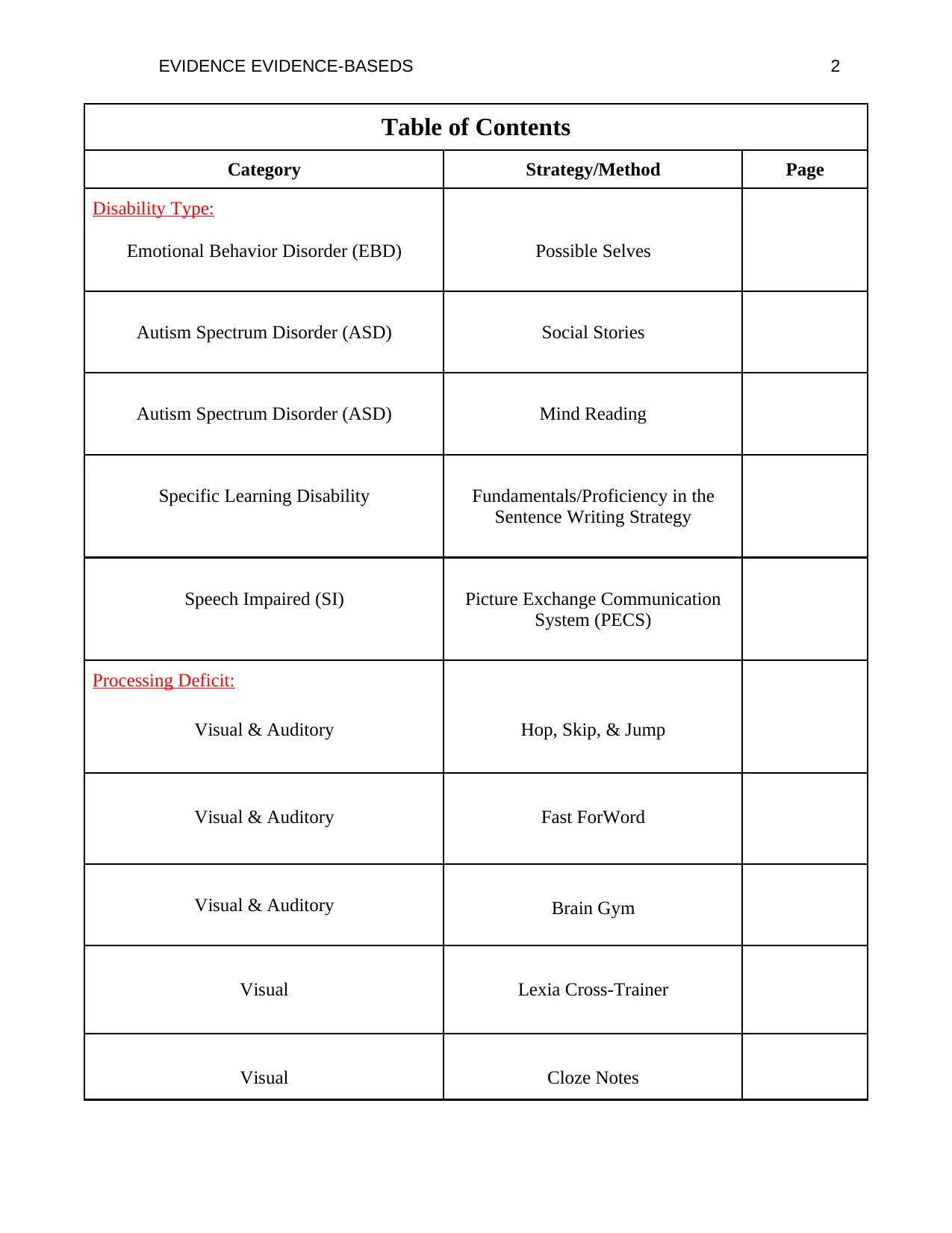
EVIDENCE EVIDENCE-BASEDS 2
Table of Contents
Category Strategy/Method Page
Disability Type:
Emotional Behavior Disorder (EBD) Possible Selves
Autism Spectrum Disorder (ASD) Social Stories
Autism Spectrum Disorder (ASD) Mind Reading
Specific Learning Disability Fundamentals/Proficiency in the
Sentence Writing Strategy
Speech Impaired (SI) Picture Exchange Communication
System (PECS)
Processing Deficit:
Visual & Auditory Hop, Skip, & Jump
Visual & Auditory Fast ForWord
Visual & Auditory Brain Gym
Visual Lexia Cross-Trainer
Visual Cloze Notes
Table of Contents
Category Strategy/Method Page
Disability Type:
Emotional Behavior Disorder (EBD) Possible Selves
Autism Spectrum Disorder (ASD) Social Stories
Autism Spectrum Disorder (ASD) Mind Reading
Specific Learning Disability Fundamentals/Proficiency in the
Sentence Writing Strategy
Speech Impaired (SI) Picture Exchange Communication
System (PECS)
Processing Deficit:
Visual & Auditory Hop, Skip, & Jump
Visual & Auditory Fast ForWord
Visual & Auditory Brain Gym
Visual Lexia Cross-Trainer
Visual Cloze Notes
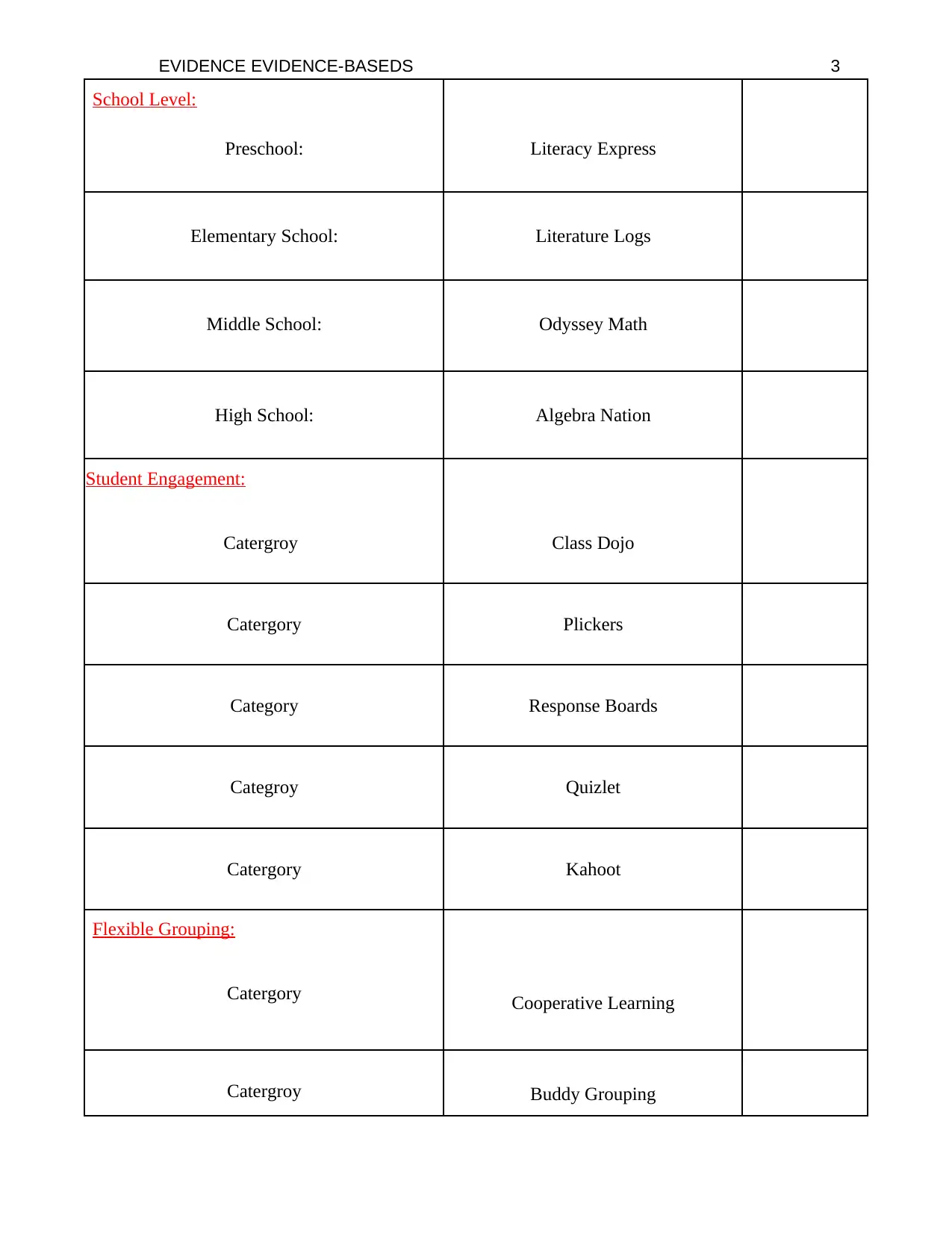
EVIDENCE EVIDENCE-BASEDS 3
School Level:
Preschool: Literacy Express
Elementary School: Literature Logs
Middle School: Odyssey Math
High School: Algebra Nation
Student Engagement:
Catergroy Class Dojo
Catergory Plickers
Category Response Boards
Categroy Quizlet
Catergory Kahoot
Flexible Grouping:
Catergory Cooperative Learning
Catergroy Buddy Grouping
School Level:
Preschool: Literacy Express
Elementary School: Literature Logs
Middle School: Odyssey Math
High School: Algebra Nation
Student Engagement:
Catergroy Class Dojo
Catergory Plickers
Category Response Boards
Categroy Quizlet
Catergory Kahoot
Flexible Grouping:
Catergory Cooperative Learning
Catergroy Buddy Grouping
⊘ This is a preview!⊘
Do you want full access?
Subscribe today to unlock all pages.

Trusted by 1+ million students worldwide
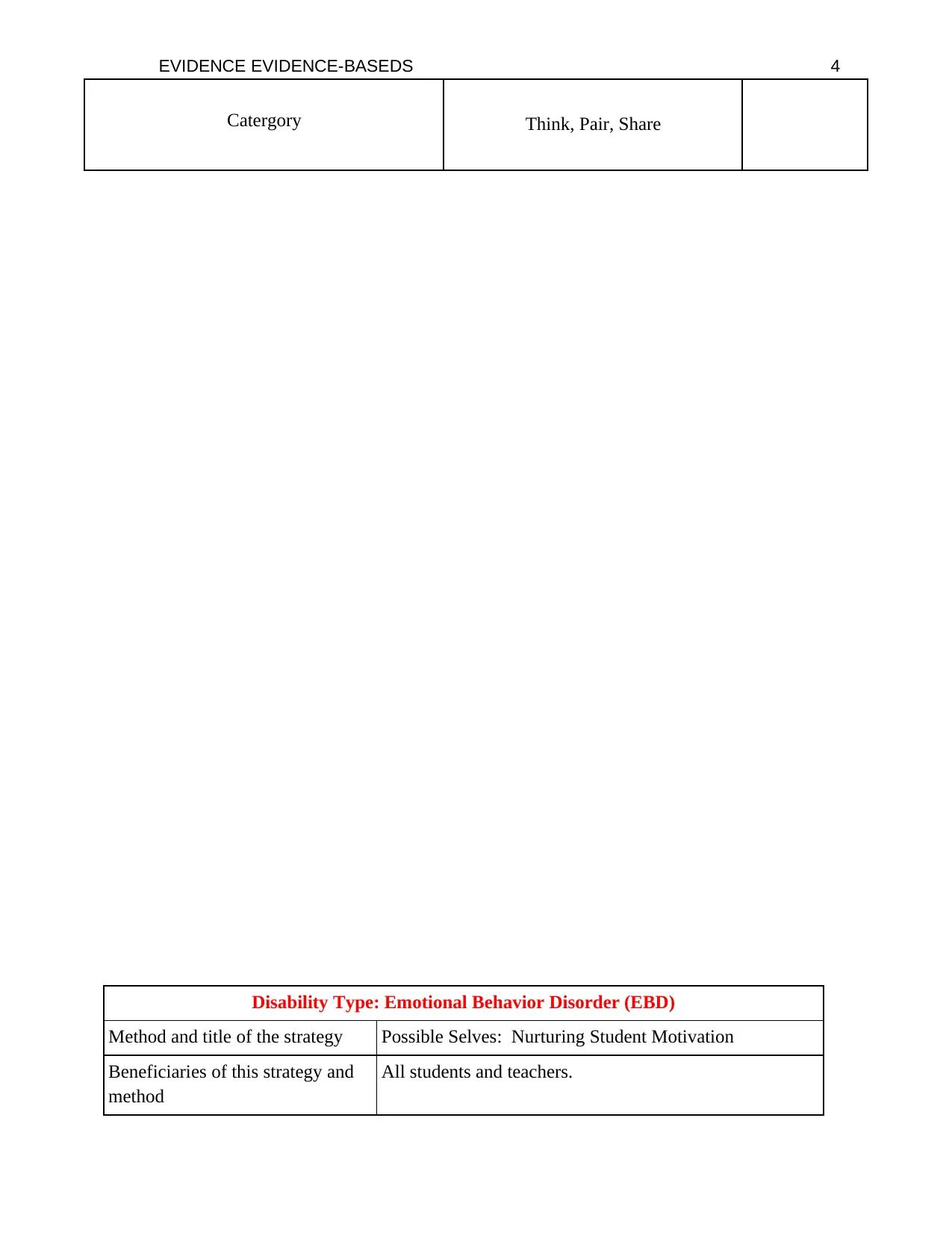
EVIDENCE EVIDENCE-BASEDS 4
Catergory Think, Pair, Share
Disability Type: Emotional Behavior Disorder (EBD)
Method and title of the strategy Possible Selves: Nurturing Student Motivation
Beneficiaries of this strategy and
method
All students and teachers.
Catergory Think, Pair, Share
Disability Type: Emotional Behavior Disorder (EBD)
Method and title of the strategy Possible Selves: Nurturing Student Motivation
Beneficiaries of this strategy and
method
All students and teachers.
Paraphrase This Document
Need a fresh take? Get an instant paraphrase of this document with our AI Paraphraser
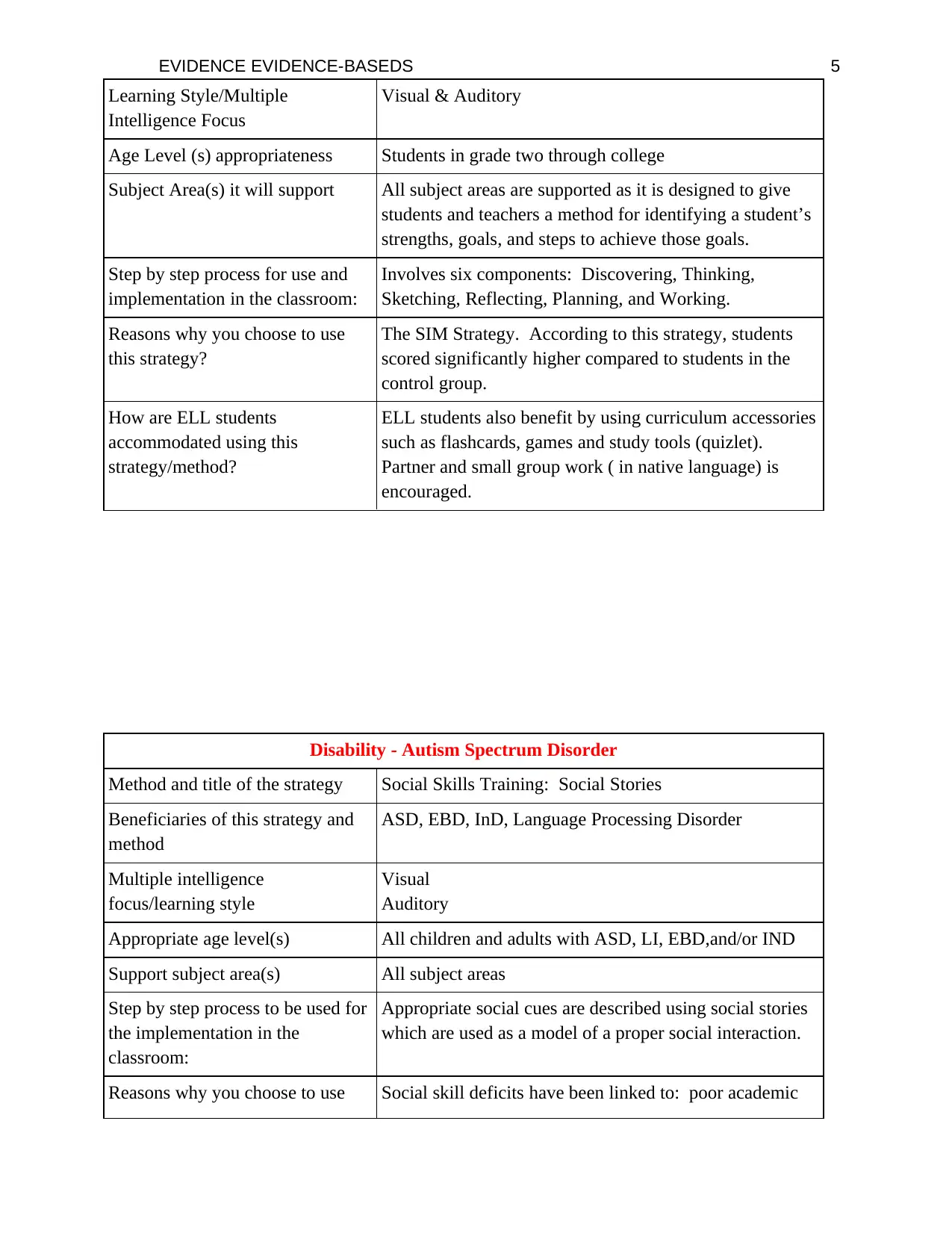
EVIDENCE EVIDENCE-BASEDS 5
Learning Style/Multiple
Intelligence Focus
Visual & Auditory
Age Level (s) appropriateness Students in grade two through college
Subject Area(s) it will support All subject areas are supported as it is designed to give
students and teachers a method for identifying a student’s
strengths, goals, and steps to achieve those goals.
Step by step process for use and
implementation in the classroom:
Involves six components: Discovering, Thinking,
Sketching, Reflecting, Planning, and Working.
Reasons why you choose to use
this strategy?
The SIM Strategy. According to this strategy, students
scored significantly higher compared to students in the
control group.
How are ELL students
accommodated using this
strategy/method?
ELL students also benefit by using curriculum accessories
such as flashcards, games and study tools (quizlet).
Partner and small group work ( in native language) is
encouraged.
Disability - Autism Spectrum Disorder
Method and title of the strategy Social Skills Training: Social Stories
Beneficiaries of this strategy and
method
ASD, EBD, InD, Language Processing Disorder
Multiple intelligence
focus/learning style
Visual
Auditory
Appropriate age level(s) All children and adults with ASD, LI, EBD,and/or IND
Support subject area(s) All subject areas
Step by step process to be used for
the implementation in the
classroom:
Appropriate social cues are described using social stories
which are used as a model of a proper social interaction.
Reasons why you choose to use Social skill deficits have been linked to: poor academic
Learning Style/Multiple
Intelligence Focus
Visual & Auditory
Age Level (s) appropriateness Students in grade two through college
Subject Area(s) it will support All subject areas are supported as it is designed to give
students and teachers a method for identifying a student’s
strengths, goals, and steps to achieve those goals.
Step by step process for use and
implementation in the classroom:
Involves six components: Discovering, Thinking,
Sketching, Reflecting, Planning, and Working.
Reasons why you choose to use
this strategy?
The SIM Strategy. According to this strategy, students
scored significantly higher compared to students in the
control group.
How are ELL students
accommodated using this
strategy/method?
ELL students also benefit by using curriculum accessories
such as flashcards, games and study tools (quizlet).
Partner and small group work ( in native language) is
encouraged.
Disability - Autism Spectrum Disorder
Method and title of the strategy Social Skills Training: Social Stories
Beneficiaries of this strategy and
method
ASD, EBD, InD, Language Processing Disorder
Multiple intelligence
focus/learning style
Visual
Auditory
Appropriate age level(s) All children and adults with ASD, LI, EBD,and/or IND
Support subject area(s) All subject areas
Step by step process to be used for
the implementation in the
classroom:
Appropriate social cues are described using social stories
which are used as a model of a proper social interaction.
Reasons why you choose to use Social skill deficits have been linked to: poor academic
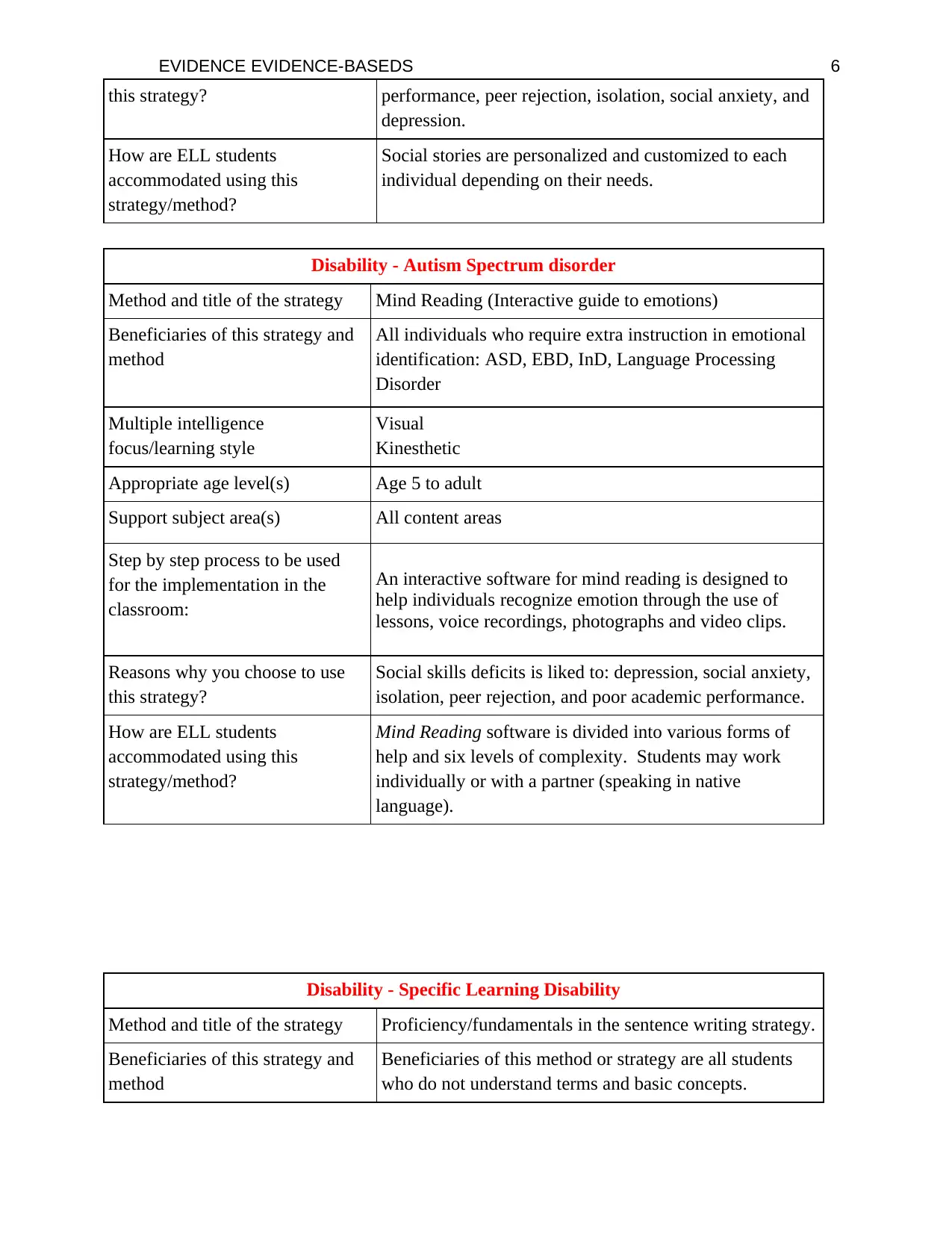
EVIDENCE EVIDENCE-BASEDS 6
this strategy? performance, peer rejection, isolation, social anxiety, and
depression.
How are ELL students
accommodated using this
strategy/method?
Social stories are personalized and customized to each
individual depending on their needs.
Disability - Autism Spectrum disorder
Method and title of the strategy Mind Reading (Interactive guide to emotions)
Beneficiaries of this strategy and
method
All individuals who require extra instruction in emotional
identification: ASD, EBD, InD, Language Processing
Disorder
Multiple intelligence
focus/learning style
Visual
Kinesthetic
Appropriate age level(s) Age 5 to adult
Support subject area(s) All content areas
Step by step process to be used
for the implementation in the
classroom:
An interactive software for mind reading is designed to
help individuals recognize emotion through the use of
lessons, voice recordings, photographs and video clips.
Reasons why you choose to use
this strategy?
Social skills deficits is liked to: depression, social anxiety,
isolation, peer rejection, and poor academic performance.
How are ELL students
accommodated using this
strategy/method?
Mind Reading software is divided into various forms of
help and six levels of complexity. Students may work
individually or with a partner (speaking in native
language).
Disability - Specific Learning Disability
Method and title of the strategy Proficiency/fundamentals in the sentence writing strategy.
Beneficiaries of this strategy and
method
Beneficiaries of this method or strategy are all students
who do not understand terms and basic concepts.
this strategy? performance, peer rejection, isolation, social anxiety, and
depression.
How are ELL students
accommodated using this
strategy/method?
Social stories are personalized and customized to each
individual depending on their needs.
Disability - Autism Spectrum disorder
Method and title of the strategy Mind Reading (Interactive guide to emotions)
Beneficiaries of this strategy and
method
All individuals who require extra instruction in emotional
identification: ASD, EBD, InD, Language Processing
Disorder
Multiple intelligence
focus/learning style
Visual
Kinesthetic
Appropriate age level(s) Age 5 to adult
Support subject area(s) All content areas
Step by step process to be used
for the implementation in the
classroom:
An interactive software for mind reading is designed to
help individuals recognize emotion through the use of
lessons, voice recordings, photographs and video clips.
Reasons why you choose to use
this strategy?
Social skills deficits is liked to: depression, social anxiety,
isolation, peer rejection, and poor academic performance.
How are ELL students
accommodated using this
strategy/method?
Mind Reading software is divided into various forms of
help and six levels of complexity. Students may work
individually or with a partner (speaking in native
language).
Disability - Specific Learning Disability
Method and title of the strategy Proficiency/fundamentals in the sentence writing strategy.
Beneficiaries of this strategy and
method
Beneficiaries of this method or strategy are all students
who do not understand terms and basic concepts.
⊘ This is a preview!⊘
Do you want full access?
Subscribe today to unlock all pages.

Trusted by 1+ million students worldwide
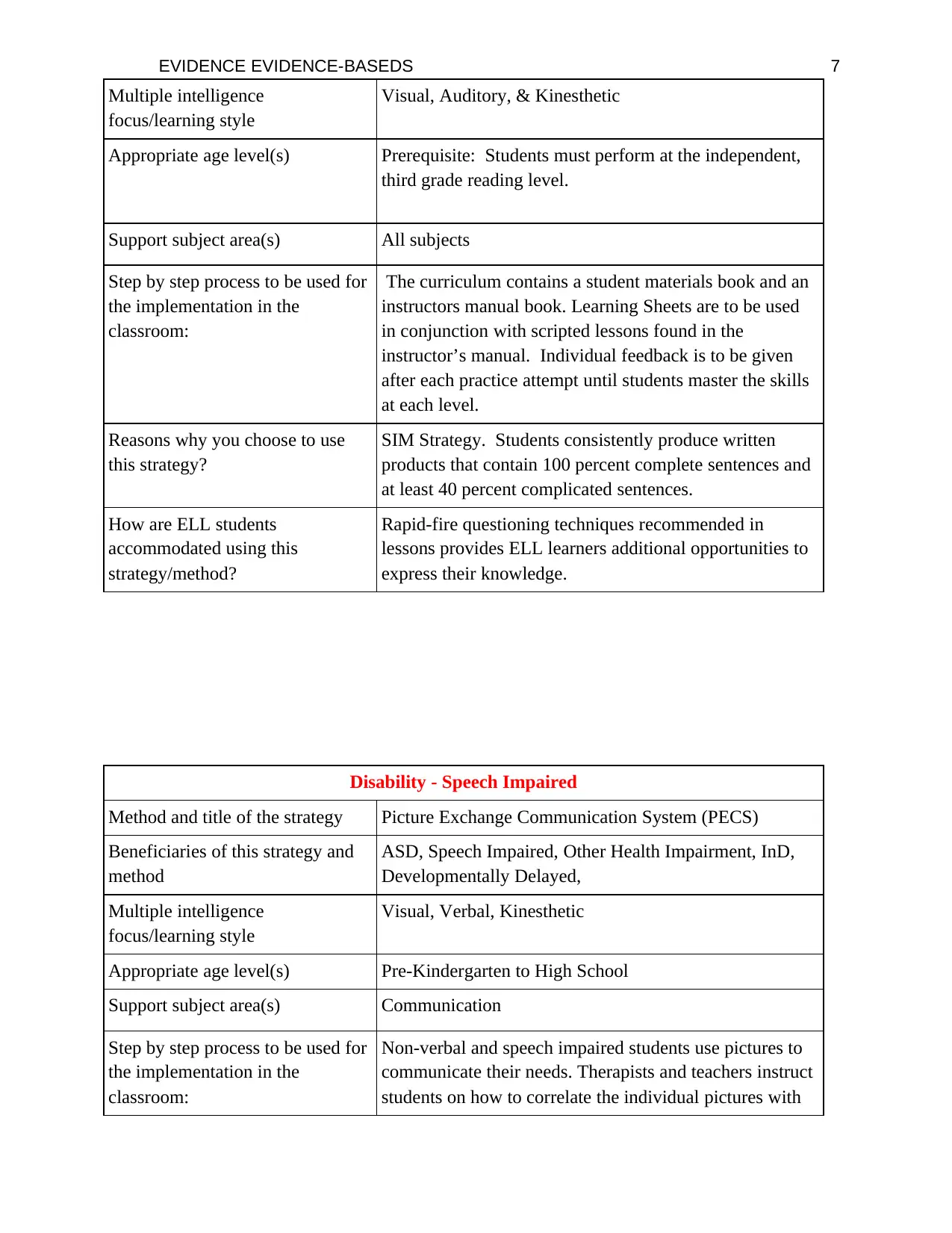
EVIDENCE EVIDENCE-BASEDS 7
Multiple intelligence
focus/learning style
Visual, Auditory, & Kinesthetic
Appropriate age level(s) Prerequisite: Students must perform at the independent,
third grade reading level.
Support subject area(s) All subjects
Step by step process to be used for
the implementation in the
classroom:
The curriculum contains a student materials book and an
instructors manual book. Learning Sheets are to be used
in conjunction with scripted lessons found in the
instructor’s manual. Individual feedback is to be given
after each practice attempt until students master the skills
at each level.
Reasons why you choose to use
this strategy?
SIM Strategy. Students consistently produce written
products that contain 100 percent complete sentences and
at least 40 percent complicated sentences.
How are ELL students
accommodated using this
strategy/method?
Rapid-fire questioning techniques recommended in
lessons provides ELL learners additional opportunities to
express their knowledge.
Disability - Speech Impaired
Method and title of the strategy Picture Exchange Communication System (PECS)
Beneficiaries of this strategy and
method
ASD, Speech Impaired, Other Health Impairment, InD,
Developmentally Delayed,
Multiple intelligence
focus/learning style
Visual, Verbal, Kinesthetic
Appropriate age level(s) Pre-Kindergarten to High School
Support subject area(s) Communication
Step by step process to be used for
the implementation in the
classroom:
Non-verbal and speech impaired students use pictures to
communicate their needs. Therapists and teachers instruct
students on how to correlate the individual pictures with
Multiple intelligence
focus/learning style
Visual, Auditory, & Kinesthetic
Appropriate age level(s) Prerequisite: Students must perform at the independent,
third grade reading level.
Support subject area(s) All subjects
Step by step process to be used for
the implementation in the
classroom:
The curriculum contains a student materials book and an
instructors manual book. Learning Sheets are to be used
in conjunction with scripted lessons found in the
instructor’s manual. Individual feedback is to be given
after each practice attempt until students master the skills
at each level.
Reasons why you choose to use
this strategy?
SIM Strategy. Students consistently produce written
products that contain 100 percent complete sentences and
at least 40 percent complicated sentences.
How are ELL students
accommodated using this
strategy/method?
Rapid-fire questioning techniques recommended in
lessons provides ELL learners additional opportunities to
express their knowledge.
Disability - Speech Impaired
Method and title of the strategy Picture Exchange Communication System (PECS)
Beneficiaries of this strategy and
method
ASD, Speech Impaired, Other Health Impairment, InD,
Developmentally Delayed,
Multiple intelligence
focus/learning style
Visual, Verbal, Kinesthetic
Appropriate age level(s) Pre-Kindergarten to High School
Support subject area(s) Communication
Step by step process to be used for
the implementation in the
classroom:
Non-verbal and speech impaired students use pictures to
communicate their needs. Therapists and teachers instruct
students on how to correlate the individual pictures with
Paraphrase This Document
Need a fresh take? Get an instant paraphrase of this document with our AI Paraphraser
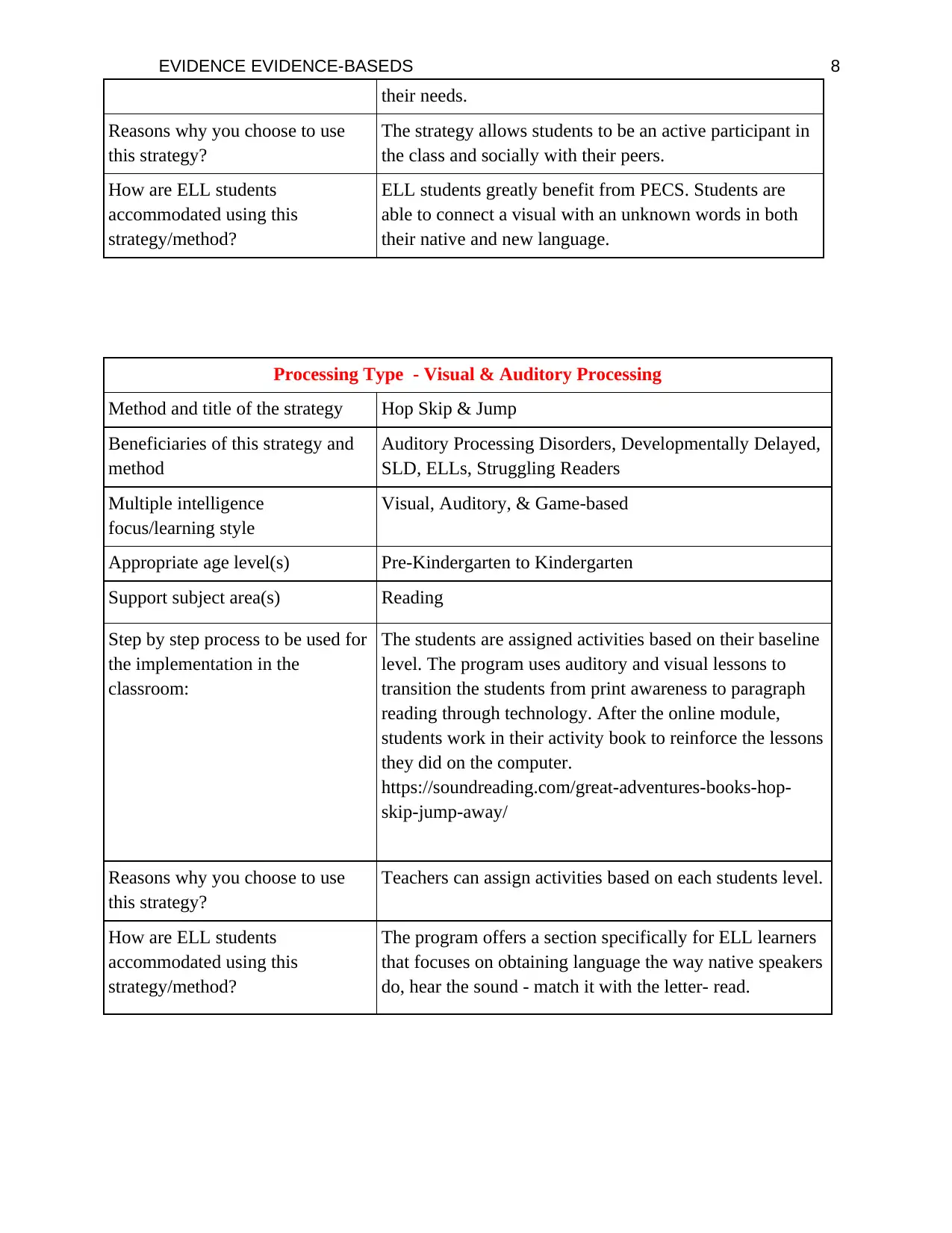
EVIDENCE EVIDENCE-BASEDS 8
their needs.
Reasons why you choose to use
this strategy?
The strategy allows students to be an active participant in
the class and socially with their peers.
How are ELL students
accommodated using this
strategy/method?
ELL students greatly benefit from PECS. Students are
able to connect a visual with an unknown words in both
their native and new language.
Processing Type - Visual & Auditory Processing
Method and title of the strategy Hop Skip & Jump
Beneficiaries of this strategy and
method
Auditory Processing Disorders, Developmentally Delayed,
SLD, ELLs, Struggling Readers
Multiple intelligence
focus/learning style
Visual, Auditory, & Game-based
Appropriate age level(s) Pre-Kindergarten to Kindergarten
Support subject area(s) Reading
Step by step process to be used for
the implementation in the
classroom:
The students are assigned activities based on their baseline
level. The program uses auditory and visual lessons to
transition the students from print awareness to paragraph
reading through technology. After the online module,
students work in their activity book to reinforce the lessons
they did on the computer.
https://soundreading.com/great-adventures-books-hop-
skip-jump-away/
Reasons why you choose to use
this strategy?
Teachers can assign activities based on each students level.
How are ELL students
accommodated using this
strategy/method?
The program offers a section specifically for ELL learners
that focuses on obtaining language the way native speakers
do, hear the sound - match it with the letter- read.
their needs.
Reasons why you choose to use
this strategy?
The strategy allows students to be an active participant in
the class and socially with their peers.
How are ELL students
accommodated using this
strategy/method?
ELL students greatly benefit from PECS. Students are
able to connect a visual with an unknown words in both
their native and new language.
Processing Type - Visual & Auditory Processing
Method and title of the strategy Hop Skip & Jump
Beneficiaries of this strategy and
method
Auditory Processing Disorders, Developmentally Delayed,
SLD, ELLs, Struggling Readers
Multiple intelligence
focus/learning style
Visual, Auditory, & Game-based
Appropriate age level(s) Pre-Kindergarten to Kindergarten
Support subject area(s) Reading
Step by step process to be used for
the implementation in the
classroom:
The students are assigned activities based on their baseline
level. The program uses auditory and visual lessons to
transition the students from print awareness to paragraph
reading through technology. After the online module,
students work in their activity book to reinforce the lessons
they did on the computer.
https://soundreading.com/great-adventures-books-hop-
skip-jump-away/
Reasons why you choose to use
this strategy?
Teachers can assign activities based on each students level.
How are ELL students
accommodated using this
strategy/method?
The program offers a section specifically for ELL learners
that focuses on obtaining language the way native speakers
do, hear the sound - match it with the letter- read.
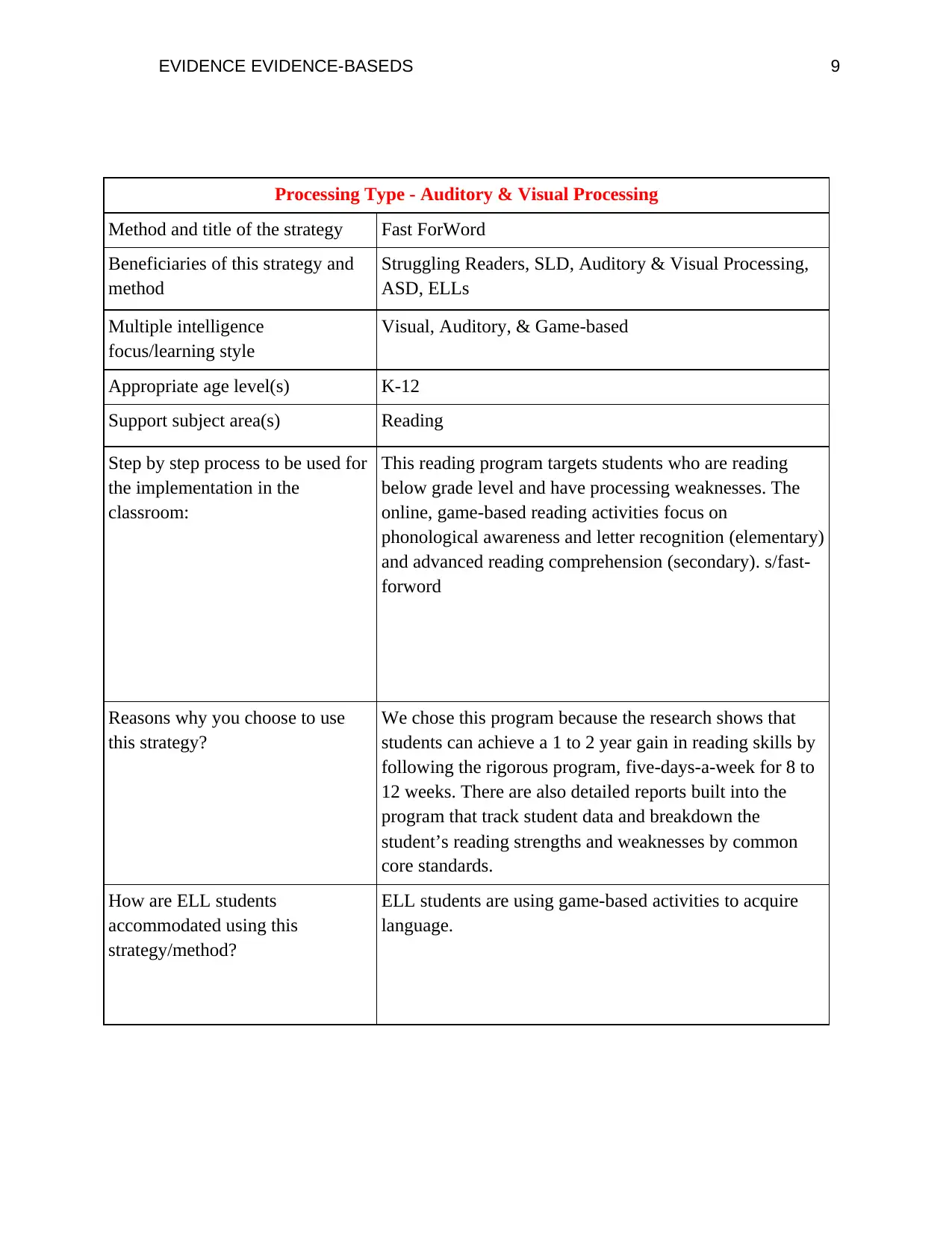
EVIDENCE EVIDENCE-BASEDS 9
Processing Type - Auditory & Visual Processing
Method and title of the strategy Fast ForWord
Beneficiaries of this strategy and
method
Struggling Readers, SLD, Auditory & Visual Processing,
ASD, ELLs
Multiple intelligence
focus/learning style
Visual, Auditory, & Game-based
Appropriate age level(s) K-12
Support subject area(s) Reading
Step by step process to be used for
the implementation in the
classroom:
This reading program targets students who are reading
below grade level and have processing weaknesses. The
online, game-based reading activities focus on
phonological awareness and letter recognition (elementary)
and advanced reading comprehension (secondary). s/fast-
forword
Reasons why you choose to use
this strategy?
We chose this program because the research shows that
students can achieve a 1 to 2 year gain in reading skills by
following the rigorous program, five-days-a-week for 8 to
12 weeks. There are also detailed reports built into the
program that track student data and breakdown the
student’s reading strengths and weaknesses by common
core standards.
How are ELL students
accommodated using this
strategy/method?
ELL students are using game-based activities to acquire
language.
Processing Type - Auditory & Visual Processing
Method and title of the strategy Fast ForWord
Beneficiaries of this strategy and
method
Struggling Readers, SLD, Auditory & Visual Processing,
ASD, ELLs
Multiple intelligence
focus/learning style
Visual, Auditory, & Game-based
Appropriate age level(s) K-12
Support subject area(s) Reading
Step by step process to be used for
the implementation in the
classroom:
This reading program targets students who are reading
below grade level and have processing weaknesses. The
online, game-based reading activities focus on
phonological awareness and letter recognition (elementary)
and advanced reading comprehension (secondary). s/fast-
forword
Reasons why you choose to use
this strategy?
We chose this program because the research shows that
students can achieve a 1 to 2 year gain in reading skills by
following the rigorous program, five-days-a-week for 8 to
12 weeks. There are also detailed reports built into the
program that track student data and breakdown the
student’s reading strengths and weaknesses by common
core standards.
How are ELL students
accommodated using this
strategy/method?
ELL students are using game-based activities to acquire
language.
⊘ This is a preview!⊘
Do you want full access?
Subscribe today to unlock all pages.

Trusted by 1+ million students worldwide
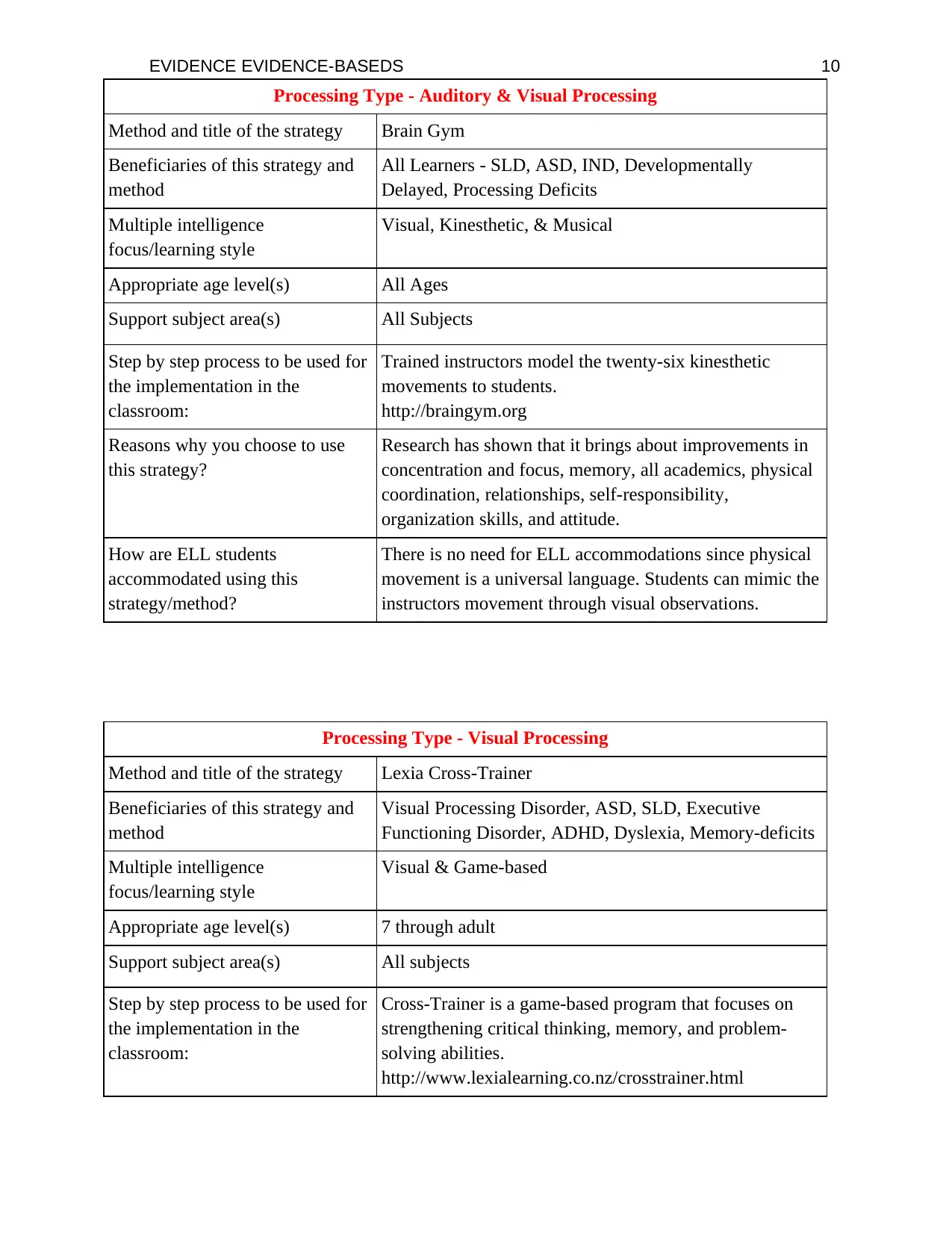
EVIDENCE EVIDENCE-BASEDS 10
Processing Type - Auditory & Visual Processing
Method and title of the strategy Brain Gym
Beneficiaries of this strategy and
method
All Learners - SLD, ASD, IND, Developmentally
Delayed, Processing Deficits
Multiple intelligence
focus/learning style
Visual, Kinesthetic, & Musical
Appropriate age level(s) All Ages
Support subject area(s) All Subjects
Step by step process to be used for
the implementation in the
classroom:
Trained instructors model the twenty-six kinesthetic
movements to students.
http://braingym.org
Reasons why you choose to use
this strategy?
Research has shown that it brings about improvements in
concentration and focus, memory, all academics, physical
coordination, relationships, self-responsibility,
organization skills, and attitude.
How are ELL students
accommodated using this
strategy/method?
There is no need for ELL accommodations since physical
movement is a universal language. Students can mimic the
instructors movement through visual observations.
Processing Type - Visual Processing
Method and title of the strategy Lexia Cross-Trainer
Beneficiaries of this strategy and
method
Visual Processing Disorder, ASD, SLD, Executive
Functioning Disorder, ADHD, Dyslexia, Memory-deficits
Multiple intelligence
focus/learning style
Visual & Game-based
Appropriate age level(s) 7 through adult
Support subject area(s) All subjects
Step by step process to be used for
the implementation in the
classroom:
Cross-Trainer is a game-based program that focuses on
strengthening critical thinking, memory, and problem-
solving abilities.
http://www.lexialearning.co.nz/crosstrainer.html
Processing Type - Auditory & Visual Processing
Method and title of the strategy Brain Gym
Beneficiaries of this strategy and
method
All Learners - SLD, ASD, IND, Developmentally
Delayed, Processing Deficits
Multiple intelligence
focus/learning style
Visual, Kinesthetic, & Musical
Appropriate age level(s) All Ages
Support subject area(s) All Subjects
Step by step process to be used for
the implementation in the
classroom:
Trained instructors model the twenty-six kinesthetic
movements to students.
http://braingym.org
Reasons why you choose to use
this strategy?
Research has shown that it brings about improvements in
concentration and focus, memory, all academics, physical
coordination, relationships, self-responsibility,
organization skills, and attitude.
How are ELL students
accommodated using this
strategy/method?
There is no need for ELL accommodations since physical
movement is a universal language. Students can mimic the
instructors movement through visual observations.
Processing Type - Visual Processing
Method and title of the strategy Lexia Cross-Trainer
Beneficiaries of this strategy and
method
Visual Processing Disorder, ASD, SLD, Executive
Functioning Disorder, ADHD, Dyslexia, Memory-deficits
Multiple intelligence
focus/learning style
Visual & Game-based
Appropriate age level(s) 7 through adult
Support subject area(s) All subjects
Step by step process to be used for
the implementation in the
classroom:
Cross-Trainer is a game-based program that focuses on
strengthening critical thinking, memory, and problem-
solving abilities.
http://www.lexialearning.co.nz/crosstrainer.html
Paraphrase This Document
Need a fresh take? Get an instant paraphrase of this document with our AI Paraphraser
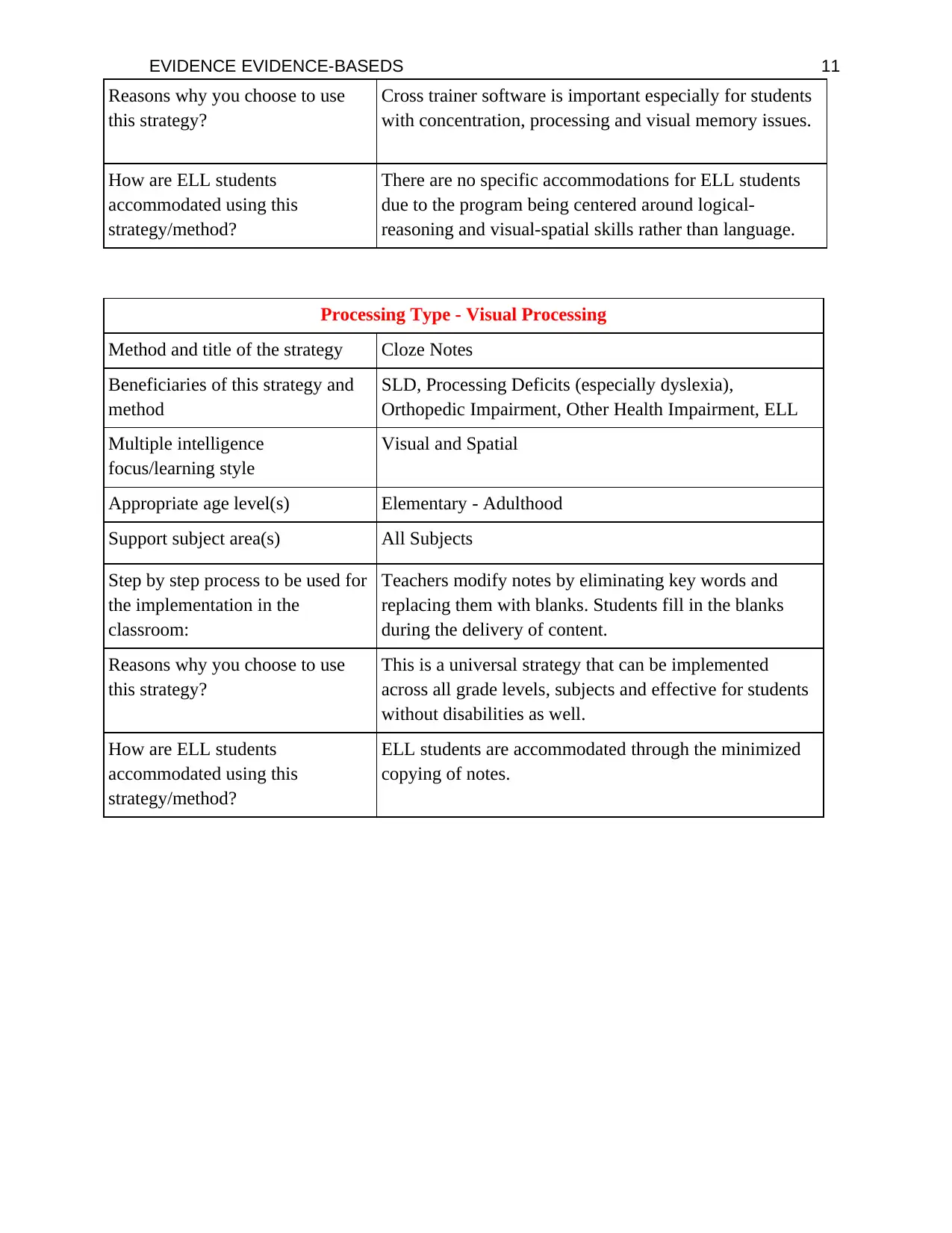
EVIDENCE EVIDENCE-BASEDS 11
Reasons why you choose to use
this strategy?
Cross trainer software is important especially for students
with concentration, processing and visual memory issues.
How are ELL students
accommodated using this
strategy/method?
There are no specific accommodations for ELL students
due to the program being centered around logical-
reasoning and visual-spatial skills rather than language.
Processing Type - Visual Processing
Method and title of the strategy Cloze Notes
Beneficiaries of this strategy and
method
SLD, Processing Deficits (especially dyslexia),
Orthopedic Impairment, Other Health Impairment, ELL
Multiple intelligence
focus/learning style
Visual and Spatial
Appropriate age level(s) Elementary - Adulthood
Support subject area(s) All Subjects
Step by step process to be used for
the implementation in the
classroom:
Teachers modify notes by eliminating key words and
replacing them with blanks. Students fill in the blanks
during the delivery of content.
Reasons why you choose to use
this strategy?
This is a universal strategy that can be implemented
across all grade levels, subjects and effective for students
without disabilities as well.
How are ELL students
accommodated using this
strategy/method?
ELL students are accommodated through the minimized
copying of notes.
Reasons why you choose to use
this strategy?
Cross trainer software is important especially for students
with concentration, processing and visual memory issues.
How are ELL students
accommodated using this
strategy/method?
There are no specific accommodations for ELL students
due to the program being centered around logical-
reasoning and visual-spatial skills rather than language.
Processing Type - Visual Processing
Method and title of the strategy Cloze Notes
Beneficiaries of this strategy and
method
SLD, Processing Deficits (especially dyslexia),
Orthopedic Impairment, Other Health Impairment, ELL
Multiple intelligence
focus/learning style
Visual and Spatial
Appropriate age level(s) Elementary - Adulthood
Support subject area(s) All Subjects
Step by step process to be used for
the implementation in the
classroom:
Teachers modify notes by eliminating key words and
replacing them with blanks. Students fill in the blanks
during the delivery of content.
Reasons why you choose to use
this strategy?
This is a universal strategy that can be implemented
across all grade levels, subjects and effective for students
without disabilities as well.
How are ELL students
accommodated using this
strategy/method?
ELL students are accommodated through the minimized
copying of notes.
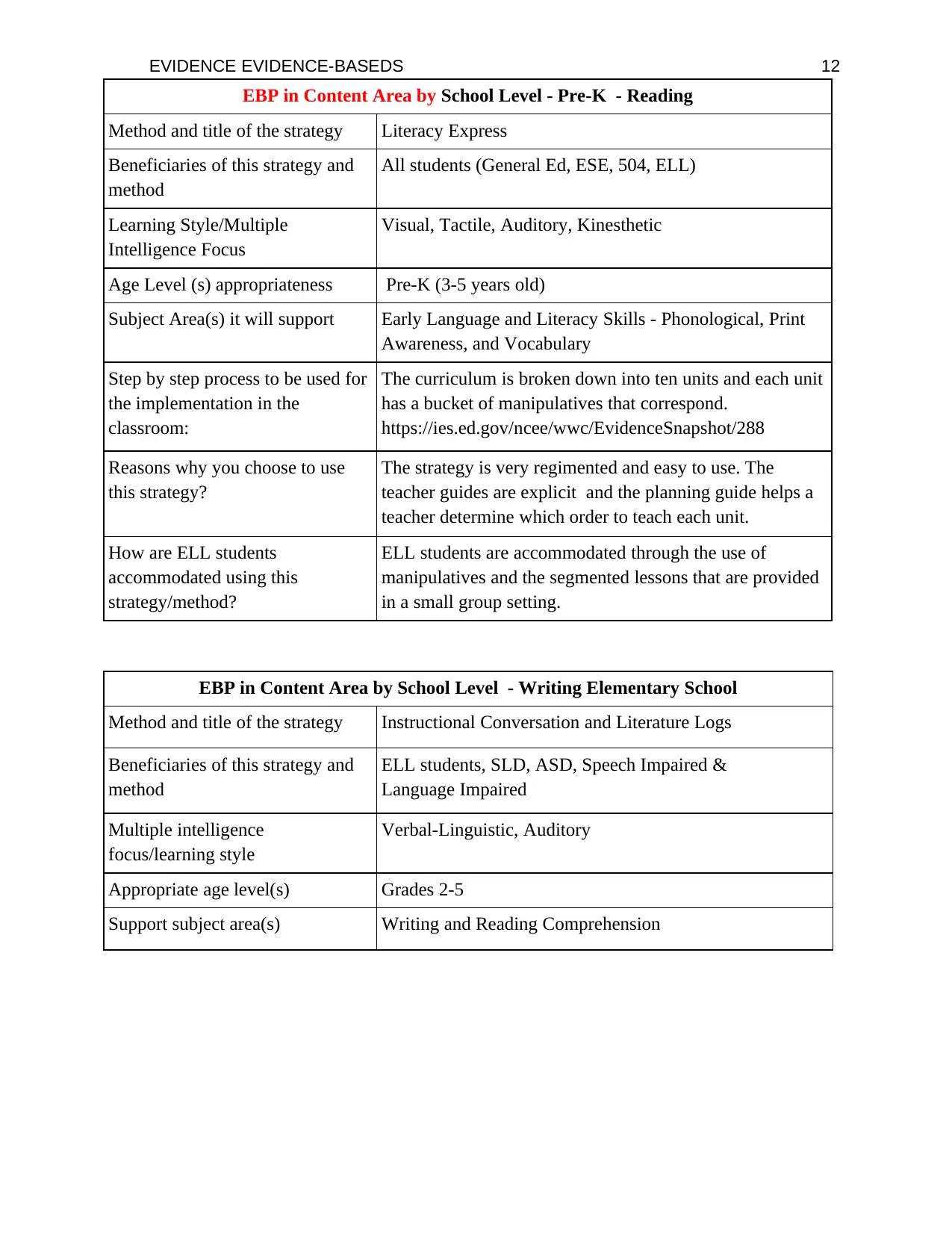
EVIDENCE EVIDENCE-BASEDS 12
EBP in Content Area by School Level - Pre-K - Reading
Method and title of the strategy Literacy Express
Beneficiaries of this strategy and
method
All students (General Ed, ESE, 504, ELL)
Learning Style/Multiple
Intelligence Focus
Visual, Tactile, Auditory, Kinesthetic
Age Level (s) appropriateness Pre-K (3-5 years old)
Subject Area(s) it will support Early Language and Literacy Skills - Phonological, Print
Awareness, and Vocabulary
Step by step process to be used for
the implementation in the
classroom:
The curriculum is broken down into ten units and each unit
has a bucket of manipulatives that correspond.
https://ies.ed.gov/ncee/wwc/EvidenceSnapshot/288
Reasons why you choose to use
this strategy?
The strategy is very regimented and easy to use. The
teacher guides are explicit and the planning guide helps a
teacher determine which order to teach each unit.
How are ELL students
accommodated using this
strategy/method?
ELL students are accommodated through the use of
manipulatives and the segmented lessons that are provided
in a small group setting.
EBP in Content Area by School Level - Writing Elementary School
Method and title of the strategy Instructional Conversation and Literature Logs
Beneficiaries of this strategy and
method
ELL students, SLD, ASD, Speech Impaired &
Language Impaired
Multiple intelligence
focus/learning style
Verbal-Linguistic, Auditory
Appropriate age level(s) Grades 2-5
Support subject area(s) Writing and Reading Comprehension
EBP in Content Area by School Level - Pre-K - Reading
Method and title of the strategy Literacy Express
Beneficiaries of this strategy and
method
All students (General Ed, ESE, 504, ELL)
Learning Style/Multiple
Intelligence Focus
Visual, Tactile, Auditory, Kinesthetic
Age Level (s) appropriateness Pre-K (3-5 years old)
Subject Area(s) it will support Early Language and Literacy Skills - Phonological, Print
Awareness, and Vocabulary
Step by step process to be used for
the implementation in the
classroom:
The curriculum is broken down into ten units and each unit
has a bucket of manipulatives that correspond.
https://ies.ed.gov/ncee/wwc/EvidenceSnapshot/288
Reasons why you choose to use
this strategy?
The strategy is very regimented and easy to use. The
teacher guides are explicit and the planning guide helps a
teacher determine which order to teach each unit.
How are ELL students
accommodated using this
strategy/method?
ELL students are accommodated through the use of
manipulatives and the segmented lessons that are provided
in a small group setting.
EBP in Content Area by School Level - Writing Elementary School
Method and title of the strategy Instructional Conversation and Literature Logs
Beneficiaries of this strategy and
method
ELL students, SLD, ASD, Speech Impaired &
Language Impaired
Multiple intelligence
focus/learning style
Verbal-Linguistic, Auditory
Appropriate age level(s) Grades 2-5
Support subject area(s) Writing and Reading Comprehension
⊘ This is a preview!⊘
Do you want full access?
Subscribe today to unlock all pages.

Trusted by 1+ million students worldwide
1 out of 22
Your All-in-One AI-Powered Toolkit for Academic Success.
+13062052269
info@desklib.com
Available 24*7 on WhatsApp / Email
![[object Object]](/_next/static/media/star-bottom.7253800d.svg)
Unlock your academic potential
Copyright © 2020–2025 A2Z Services. All Rights Reserved. Developed and managed by ZUCOL.
